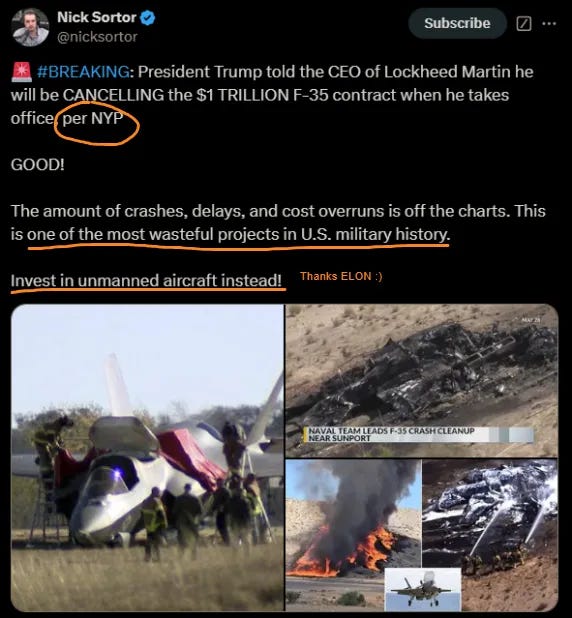How Elon Musk’s Tweets About the F-35 Opened The Door To Bad Actors
Chaos is a ladder
Update:
Due the new features we’re providing, the costs for *new* paid subscribers will increase to $10/m on Monday 12/23. This is your last chance to get a subscription at $5/m, please get it now; old subscribers will maintain their same $5/m.
Earlier this week I released an article where I broke down why Elon Musk was wrong about drones and the F-35. You can read it here:
Musk’s tweets often get a lot of attention, but his recent comments about the F-35 fighter jet caused some opportunists to take advantage. What started as Musk sharing his bad opinions on drones and jets turned into a wave of disinformation (adversarial information operation) . Let’s break down what happened!
The Chaos
Elon Musk had a series of tweets were he made the point that the F-35 was outdated and that drones were the future of warfare. He wrote things like, "Some idiots are still building manned fighter jets like the F-35," and "Manned fighter jets are obsolete in the age of drones anyway. Will just get pilots killed."
These tweets caused a storm on twitter made a lot of people debate whether fighter jets like the F-35 are still useful. Musk’s comments made it seem like drones were already better than jets in every way, but that isn’t true. While drones have made their mark, they can’t do everything a manned fighter jet can. Still, Musk’s words created a rift and left the door open for bad information to spread.
The Ladder
Two weeks after Musk’s tweets, bad actors saw the situation and jumped on the opportunity. Lydia Moynihan, a New York Post reporter, tweeted that President Trump wanted to cancel the F-35 program (she was probably tricked or paid to tweet it), but Lockheed Martin, the company that makes the F-35, said this wasn’t true.
Shady news accounts quickly picked up Moynihan’s tweet and reframed it as if the New York Post said it. Of course Moynihan’s tweet was about something she “overheard” it was not an official NYP article. They showed images of F-35 crashes and claimed the program was too expensive, even though these examples were taken out of context.
Disinformation Bots Join the Conversation
Bot accounts started to flood anyone who tweeted about the F-35 (including me). Some bots posted sarcastic comments mocking the F-35’s capabilities some claimed the Chinese J-35 was way better. Low level bot accounts often have little to no followers and post repetitive content, which makes them easier to spot. One of the main goals of a modern disinformation campaign is to build fake consensus and muddy the waters to get real people to buy in.
Bot-assisted fake social engagement operations center on the interplay among human perpetrators, automation (bots), and platform algorithms to “manufacture consensus or to otherwise give the illusion of general support for a (perhaps controversial) political idea or policy, with the goal of creating a “bandwagon effect”(Woolley & Howard, 2016, p.4, emphasis added). In information consumption contexts, the bandwagon effect is manifest in the shift of public attention to certain types of information. —Lee, Sanghak, et al. “Disinformation Spillover”
The spread of false information made people question the value of the F-35 program. Some tweets compared it to drones and China’s J-35 jet, suggesting these alternatives were better. The claims weren’t true, but they were backed up by Musk’s statements and seemingly Trump due to the Lydia tweet. The F-35 is a key part of U.S. defense and foreign arms sales. This cycle of disinformation was built to hurt public trust in the F-35 program in order to weaken political and military support for it.
This situation shows how quickly disinformation can spread online, especially when a careless famous “genius” person’s comments create confusion. Musk’s tweets probably weren’t meant to mislead, but they opened the door for others to piggy back off of the chaos and spread bad information. People need to think critically about what they see online even if they come from seemingly smart and famous people.
It also highlights the responsibility that comes with having a large platform. Someone with Musk’s influence can unintentionally make it easier for bad actors to spread falsehoods.
As always, thank you for reading.







Is it resource intensive for a country or group to have a disinformation arm to run stuff like this? It can’t be expensive right? I can’t imagine how much of the internet is a pacing and leading war